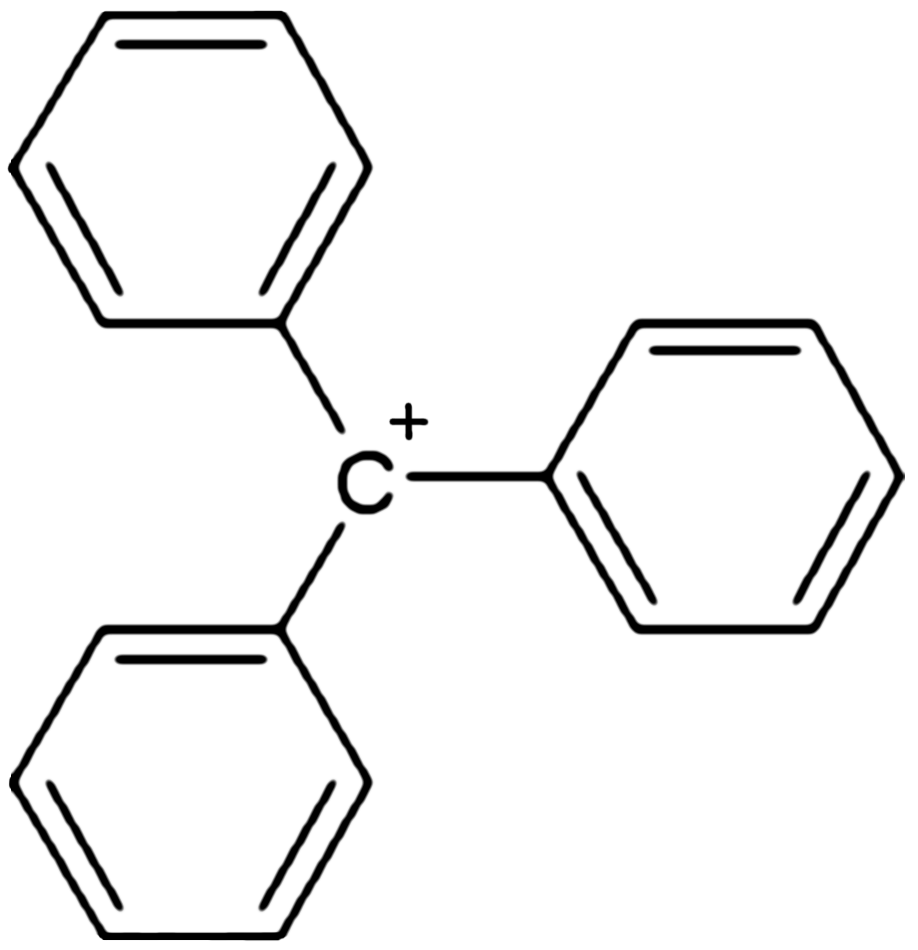Triphenylcarbenium on:
[Wikipedia]
[Google]
[Amazon]

 In
In
Image:Methyl Violet 10B.png, Crystal violet.
Image:NewFuchsineStructure.png, New fuchsine dye.
File:Pararosaniline.png, Pararosaniline
N. C. Deno, J. J. Jaruzelski, and Alan Schriesheim (1955) "Carbonium ions. I. An acidity function (''C''0) derived from arylcarbonium ion equilibria." ''Journal of the American Chemical Society'', volume 77, issue 11, pages 3044–3051.
Michael E. Jung, Roman Lagoutte, and Ullrich Jahn (2011): "Triphenylcarbenium Tetrafluoroborate". In ''Encyclopedia of Reagents for Organic Synthesis''.
E. Molins, M. Mas, W. Maniukiewicz, M. Ballester and J. Castañer (1996): "Perchlorotriphenylcarbenium Hexachloroantimonate(V)". ''Acta Crystallographica Section C (Structural Chemistry)'', volume C52, pages 2412-2414. {{doi, 10.1107/S0108270196007287
U. S. National Institutes of Health (2019)
PubChem ID 2723954 - Triphenylcarbenium hexafluorophosphate
. Entry in NCBI's PubChem database, accessed on 2019-07-25.
Carbocations

 In
In chemistry
Chemistry is the scientific study of the properties and behavior of matter. It is a physical science within the natural sciences that studies the chemical elements that make up matter and chemical compound, compounds made of atoms, molecules a ...
, triphenylcarbenium, triphenylmethyl cation, tritylium , or trityl cation is an ion with formula or , consisting of a carbon
Carbon () is a chemical element; it has chemical symbol, symbol C and atomic number 6. It is nonmetallic and tetravalence, tetravalent—meaning that its atoms are able to form up to four covalent bonds due to its valence shell exhibiting 4 ...
atom with a positive charge connected to three phenyl groups. It is a charged version of the triphenylmethyl radical . The name is often abbreviated to triphenylmethyl or trityl in salts, although these names also denote the chemical group in compounds like triphenylmethyl chloride that do not contain the cation.
Triphenylcarbenium is a relatively stable carbenium ion, because the positive charge is partially distributed among 10 of the carbon atoms (the 3 carbon atoms in the ''ortho'' and ''para'' positions of each of the three phenyl groups, plus the central carbon atom).
Derivatives
The cation exists in important chemical reagents and catalysts such as triphenylmethyl hexafluorophosphate . Related salts are known with diverse anions including tetrafluoroborate (), hexachloroantimonate (), and perchlorate (). This and other similar cations can be obtained as intensely colored solutions by dissolving aryl-substituted methanols in concentratedsulfuric acid
Sulfuric acid (American spelling and the preferred IUPAC name) or sulphuric acid (English in the Commonwealth of Nations, Commonwealth spelling), known in antiquity as oil of vitriol, is a mineral acid composed of the elements sulfur, oxygen, ...
. Derivatives of this cation include, for example, perchlorotriphenylcarbenium .
Triarylmethane dyes
Triarylmethane dyes are derivatives that are stabilized versions of the trityl cation. They are water-soluble and are often obtained as the chloride salts. These dyes have strong electron donor groups, often amines, at the ''p''-positions of two or three of the aryl groups.Thomas Gessner and Udo Mayer "Triarylmethane and Diarylmethane Dyes" inUllmann's Encyclopedia of Industrial Chemistry
''Ullmann's Encyclopedia of Industrial Chemistry'' is a major reference work related to Chemical industry, industrial chemistry by chemist Fritz Ullmann, first published in 1914, and exclusively in German as "Enzyklopädie der Technischen Chemie ...
2002, Wiley-VCH, Weinheim.
See also
* Triphenylmethane * TriphenylmethanolReferences
PubChem ID 2723954 - Triphenylcarbenium hexafluorophosphate
. Entry in NCBI's PubChem database, accessed on 2019-07-25.